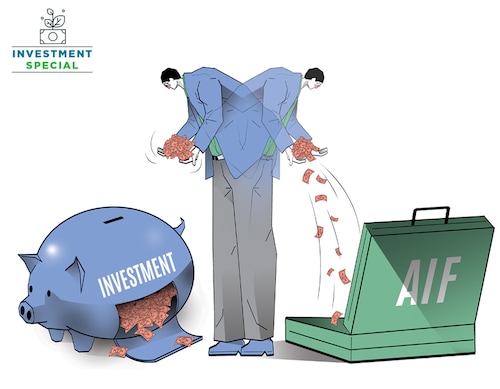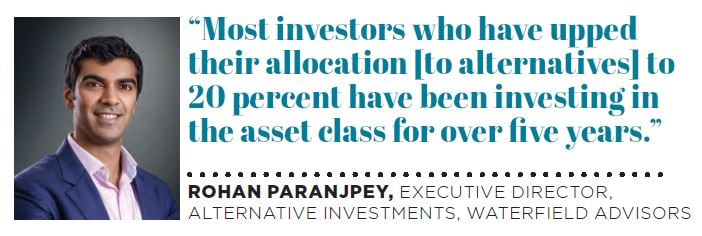The rise of 'sophisticated' investors
Alternative Investment Funds as an asset class has seen a 38 percent jump in commitments raised from domestic investors, highlighting the rise of investment in private funds


Before the pandemic, the riches were busy catching up over coffee and dropping names of the new startup they have invested in. Almost everyone believed that they had invested in a multi-bagger, but then came the pandemic, and the hoity angels’ crowd progressed to become sophisticated investors, or so the Securities and Exchange Board of India (Sebi) defines investors who invest in alternative investment funds (AIF).
As per Sebi data, as on December 30, 2021, fund managers who run AIFs raised a total of ₹609,091.7 crore across categories—a 38 percent jump from what they had raised the year before. In December 2020, the figure was ₹441,994.73 crore.
The minimum investment limit to invest in an AIF is ₹1 crore, as Sebi wants sophisticated investors who understand the underlying risk of such kind of investments.
“The rise in AIF allocation is mainly driven by clients wanting to participate in private markets through both private equity (PE) and private debt. Most clients are also investing in AIFs, which invest primarily in listed equities as these are more focussed or thematic, and are more benchmark-agnostic as compared to mutual funds.
Allocation to PE has been driven by client eagerness to participate in the new-age disruptive tech companies. Most of these companies are unlisted and only available through the AIF route," says Sahil Kapoor, senior executive vice president at IIFL Wealth. IIFL Wealth distributes more than ₹27,000 crore of AIFs on the platform, including listed equity, unlisted equity, real estate and structured credit.
One reason why capital allocation has moved towards such assets is due to lower returns on fixed income products. Another reason is that equity valuations are stretched—in fact, they are close to historic high levels due to the unleashing of liquidity by major central bankers across the world.
“A robust secondary equity market through 2020 and 2021 had led to investors eyeing the early-bird advantage by participating in pre-IPO deals, and AIFs that provide access to such deals. While 2021 was a promising year for the pre-IPO market with several successful listings, the last six months haven’t been encouraging for IPOs. It remains to be seen whether the momentum in the pre-IPO market will continue this year," says Unmesh Kulkarni, managing director, senior advisor, Julius Baer—currently the largest global wealth manager in India, according to India Onshore AUM industry research.

Adds Kulkarni, “Infrastructure and real estate trusts have also seen growing interest among investors, not from growth investors, but from investors seeking higher fixed income type of yields from their investments in the backdrop of lacklustre returns from fixed income asset class. The lowering of ticket size helps in increasing accessibility and providing some depth to these product classes."
While the entire AIF as an asset class has witnessed more capital rushing in, the one that stands out is the category of Venture Capital Funds (VCF). Indian VCF fund managers managed to raise commitments of ₹34,569.56 crore during December 2021 compared to ₹26,791.7 crore during the same period last year, an increase of 29 percent.
“The liquidity risk in private markets has reduced dramatically due to three big reasons. First, large Indian corporates are now becoming active with the Tatas investing $1 billion in BigBasket, and Reliance investing $200 million in Dunzo, implying that there now exists a local base of potential acquirers for PE/VC-funded companies as compared to earlier, leading to more outcomes," says Rohan Paranjpey, executive director, alternative investments, Waterfield Advisors.
Also companies such as Zomato going public have opened the gates for others to explore a public listing. Even though the stock may have underperformed, Paranjpey believes that investors can still liquidate their holdings when required. Lastly, there are now many more private market investors in India across stages, and secondary sales of shares between funds are a lot more common today compared to a decade earlier.

Paranjpey adds, “We have seen allocations to alternatives range between 0 percent and 20 percent. Most investors who have upped their allocation to 20 percent are ones who have been consistently investing in the asset class for over five years, have seen a complete cycle and have seen liquidity."
Fund managers have come a long way this past decade, and now India has a wide range of managers with track records and a wealth of experience. At the same time, newer managers have emerged, breaking away from global shops like Sequoia and Warburg Pincus they are launching their own franchises. Typically, the new managers prefer to set up an AIF and raise capital from domestic investors, where their personal networks are stronger.
While the quality of managers is improving, a few firms without a strong history of private investing have also capitalised on the momentum of private companies going for an IPO by launching ‘late-stage’ or pre-IPO funds. When these funds were launched by wealth management firms, which raise funds for AIFs on a day-to-day basis, they had an inherent advantage in taking these opportunities to a broader client base. These structures appealed to the first-time private market investor because they offered a path to liquidity with a short hold like five years and through public markets.
“Back-of-the-envelope math points to ~$1 billion being raised from domestic investors in such late-stage funds. The rout in tech stocks has brought the risks of such momentum-driven investing strategies to the fore, and only time will tell how these funds will eventually perform," says Paranjpey.
Private debt allocation is driven by lower yields in listed AAA or quasi government debt papers. It has also been aided by mutual funds and non-banking financial companies’ inability to participate in a number of transactions due to change in market dynamics and regulation that transpired post the IL&FS crisis.
IIFL Wealth’s Kapoor is upbeat on private debt strategies, which focus on performing credit, but avoid turnaround or distress debt. “We are investing across classic growth companies with high return on investment and cash flows and new age disruptive tech companies, which are market leaders in their niche," he says.
Although real estate has been a laggard over the last five to six years, Kapoor sees the sector turning around and offering interesting opportunities on the back of consolidation, and early signs of revival in housing and commercial demand are visible. “Allocation to private markets (debt and equity) is typically capped in clients’ portfolios—10 percent to 20 percent. Although this asset class offers higher returns, it comes along with higher risk and very low liquidity. These strategies have long gestation periods too, so clients should be mindful before allocating to these strategies," he says.
Another popular category is Cat III—long only equity or long short (hedge funds) that employ diverse or complex trading strategies and may employ leverage, including through investment derivatives. Total allocation to CAT III is nearly ₹57,000 crore as of December 2021.
According to data from a recent industry report, 50 percent of the total CAT III allocation is into Long Only Equity Funds. Absolute return funds and Long Short equity funds are nearly 12.5 percent each. The Long Short funds, which are also referred as hedge funds globally, are gaining traction and increasing fast in terms of asset under management. Long Short funds are gaining popularity considering the lower risk equity allocation strategy they offer.
“Most of the growth that we have seen in ITI Long Short Equity Fund is in current FY22. We were nearly ₹250 crore at start of April 2021. We believe the growth is because of two reasons. The first is that we were able to build a good track record of the fund’s performance by showing asymmetric return profile, while generating equity type returns with much lower risk. Also, confidence was built among investors as we were able to protect the downside during the market fall due to Covid in February and March 2020," says Ajay Vaswani, senior vice president & business head-Alternate Investment Funds, The Investment Trust of India (ITI). Under CAT III, ITI has over ₹700 crore.
But Kulkarni cautions that it is important for investors to understand the risk-return tradeoff of asset classes while deciding their allocations. Among risk assets, it is important to keep sufficient liquidity in the portfolios in order to navigate the market cycles better.
“Allocation to listed equity investments, whether direct stocks or through mutual funds, equity PMS or long-only equity AIFs, should ideally comprise the major portion of growth capital, given the relative higher liquidity in the listed space. The last six months have seen record inflows from domestic investors into equity mutual funds. Similarly, the equity PMS industry has also witnessed stellar growth over the last couple of years, both in terms of assets under management and the number of schemes being launched by several managers. Large caps are generally preferred currently over mid and small caps," says Kulkarni.
Within listed equities, the current inflationary environment and potentially rising interest rates augur well for the BFSI sector, industrials, building materials and select commodities. On the other hand, experts expect that companies with high valuations are likely to see their valuations come under pressure with interest rates rising.
In addition to traditional debt mutual funds, investors may want to evaluate certain yield-alternative avenues such as InvITs and REITs (or even some real estate debt funds) that tend to provide steady cash flows at a time when fixed income returns are unattractive. Long-short equity funds may also be considered as yield-alternatives that can comprise part of the listed equity allocation.
Says Kulkarni, “For higher risk takers in fixed income, high-yield funds could be considered—whether credit-risk-oriented mutual funds or AIFs, or structured credit AIFs. Some allocation to gold may also be considered, with an eye on the emerging (worsening) geopolitical situation and its possible impact on derailing some of the economic recovery that has been underway in developed and emerging markets."
First Published: Mar 29, 2022, 14:19
Subscribe Now